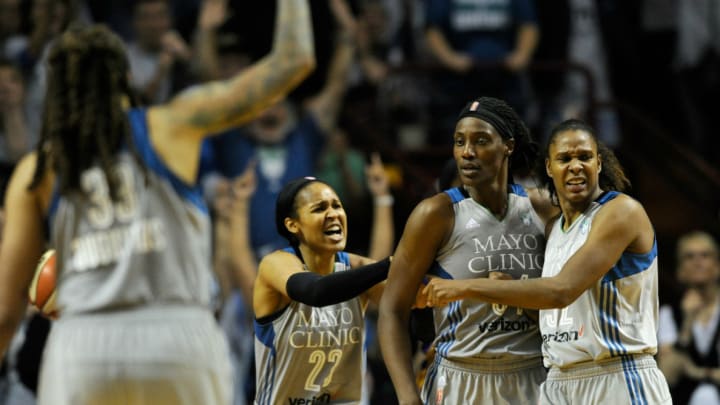The Minnesota Lynx Solidify Case as Greatest WNBA Franchise Ever

One of the smartest decisions in the 21-year history of the WNBA came in January 2016 when the league changed its playoff format to allow the eight teams with the highest winning percentages (regardless of conference) to qualify for the playoffs and be seeded based on their record. The change allowed the league’s two best teams—the Los Angeles Sparks and Minnesota Lynx—a clear path to meet in the Finals despite both residing in the Western Conference. Those teams produced spellbinding basketball over the past two Finals, a 10-game showcase of women’s basketball at its highest, most skilled and physical level.
This year’s Finals featured five of the league’s 10 All WNBA selections (L.A.’s Candace Parker, Nneka Ogwumike and Chelsea Gray and Minnesota’s Maya Moore and center Sylvia Fowles) and five U.S. Olympians (Fowles, Moore, Parker, Lynx shooting guard Seimone Augustus and point guard Lindsay Whalen). How's this for a ridiculous stat: Heading into Game 5 on Wednesday night in Minnesota, the teams were tied in points (908-908) over their last 12 meetings including the regular season and WNBA Finals.
The Fatal Flaw of the NBA’s New ‘Captain’ All-Star Format
Game 5 was terrific, especially a tense and physically taxing fourth quarter that featured Los Angeles frantically making a late run when the game looked buried. In the end, the Lynx prevailed 85-76 behind 15 points and 20 rebounds from Lynx center Sylvia Fowles. It reversed the pain of last season when Ogwumike hit a putback with 3.1 seconds left to give the Sparks the 2016 title. The 10 Finals games between the teams saw the Lynx outscore Los Angeles by just six points (774 to 759).
“Last year in Game 5 within the last two minutes, we lost two rebounds—and that hurt me for a long, long time,” said Fowles, the first player to win a regular season and WNBA Finals MVP honors since Lauren Jackson in 2010. “We came in at the beginning of the season and were like look, we lost off rebounds so that was at the top of mindset going into Game 5. I said to myself if you don’t do anything else, you have to rebound.”
That she did. Her 20 rebounds were a single game Finals record.
The Lynx held a slim 60-56 after three quarters—it was 41-35 at halftime—to set up the dramatic final quarter. Behind Fowles Minnesota asserted itself on defense and led 79-67 with two minutes left. But Los Angeles made a frantic comeback, including a 9-0 run in 56 seconds to cut the lead to 79-76. The dagger for the series came when Minnesota forward Maya Moore hit a scramble mode jumper with 26.5 left. That settled Minnesota down and they held on from there.
Five NBA All-Star Team Scenarios Worth Entertaining
“Maya made that runner, which is why she is Maya Moore,” said Whalen.
Los Angeles also deserves plenty of praise. With the 31-year-old Parker as the franchise surrounded by Ogwumike (27) and Gray (24) and Odyssey Sims (25), the Sparks are likely to win titles heading forward. But Wednesday’s win solidified the Lynx as the league’s greatest-ever franchise. Minnesota has now won titles in 2011, 2013 and 2015 and 2017. That run also includes Finals losses in 2012 and 2016.
Most notably the Finals win gave basketball fans another glimpse at arguably the least appreciated dynasty in sports. If an NBA team had reached the Finals six times over a seven-year stretch, placed four of its members on the U.S. Olympic team, and had a playoff winning percentage over .700 since 2011, such a squad would be celebrated from Boston to Boise and ESPN and Turner Sports would be politicking to air as many games nationally as they could. Alas, that is not the case for the Lynx given the low profile of the WNBA.
"It's a microcosm of society and where we place women's sports," Lynx coach Cheryl Reeve told me in 2016. "This group deserves to be celebrated for its sustained excellence."
That sustained excellence is equal parts fortune (using the No. 1 picks they got in exchange for having the league's worst record to draft can't-miss stars Augustus in 2006 and Moore in '11), prudence (trading for Fowles and Whalen, and selecting forward Rebekkah Brunson in the 2009 dispersal draft) and scouting (acquiring supporting players who could start on other teams, such as Renee Montgomery).
The Warriors Have Made the Pacific a One-Team Race
Those who have followed the sport know what a special group Minnesota has been. With four starters over 31 and the league’s oldest team at 30.22 (the Lynx have four of the five oldest players in the league), Minnesota’s window is closing fast, but what a run. “I think it will be hard to find another group as talented, as deep but as selfless as this group,” said Moore after the game.
In the postgame press conference following her fourth WNBA title as a coach, Lynx head coach Cheryl Reeve broke down at the podium when asked about putting the accomplishments of her squad in perspective.
“We’re in it for life — this group,” said Reeve, who has the highest playoff winning percentage in the history of the WNBA at 40-15. “And it is an incredible blessing to be around this group every day.”

Richard Deitsch is a writer & editor for Sports Illustrated. He has worked at nearly every division of SI and now primarily covers sports media, women’s sports & the Olympics.